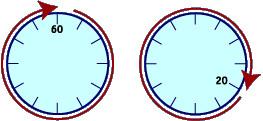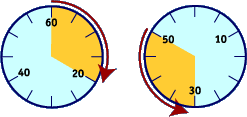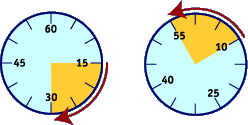How to Read a Pace Clock
Our team uses a pace clock during each and every practice. Learning to read the pace clock is a skill every advanced swimmer should develop. This section provides some helpful advice to get the most out of your practice sessions while using a pace clock.
If you have trouble seeing the clock, there are many different work around solutions. Prescription goggles, contacts under your goggles, small pace clocks next to your lane, synchronizing your wrist watch, there are lots of options!
Try to remember to keep an eye on the pace clock and push off 5 seconds behind the swimmer in front of you. This will allow enough space between swimmers for a smooth practice set.
By thinking of the clock face as a pie (pizza or a spoked wheel) it becomes easier to visualize into segments and keep track of your swims and send-off times. Listed on this page are some basic intervals along with an explanation of how to figure your next repeat.
Health Warning
Masters swimming is a strenuous athletic activity. We advise participants to consult a physician before undertaking the program. Even if you are physically fit and enjoy good health, we advise you to see your physician for periodic medical exams. The frequency of these exams would be determined by the existence of any underlying health problems. Many apparently healthy people are not aware that they possess risk factors for cardiac problems, erroneously believing that physical fitness will protect them from cardiorespiratory problems. Your health-care provider usually can take steps to detect these risk factors if they exist, and can counsel you about guidelines for a safe exercise program.
60 Second Intervals
Intervals sets that are exactly one minute (or two minutes or three minutes, etc.) are easy! What ever number you start the first set on, it will be this same number for all repeats in the entire set. For example, if you leave on the "top" or the 60 second mark, on all the following repeats, you will push off on the 60 again. If you leave on the "bottom" (no, not that kind of bottom) or the 30 second mark, on all the following repeats, you will push off on the 30 again.

30 Second Intervals
When using intervals sets that are either 30 seconds (or end in 30 seconds: 1:30, 2:30, etc.) you will always leave on one of two numbers. Those two numbers will be directly across from each other on the pace clock. For example if your set is 1:30 seconds and you leave on the 60, you push off again on the 30.

20 or 40 Second Intervals
Intervals of either 20 or 40 seconds slice the pie (pace clock) into thirds. This means you will always leave on one of three numbers.
If your interval is 20 seconds (or 1:20, 2:20, etc.) your numbers will rotate clockwise. For example, if your interval is 1:20 seconds and you push off on the 60, your next push off would be at the 20, then the 40, and then 60 again.
If your interval is 40 seconds (or 1:40, 2:40, etc.) your numbers will rotate counter-clockwise. For example, if your interval is 1:40 seconds and you push off on the 30, your next push off would be at the 10, then the 50 and then 30 again.

15 or 45 Second Intervals
Intervals of either 15 or 45 seconds will split the clock into fourths. This means that you will always leave on one of four numbers.
If your interval is 15 seconds (or 1:15, 2:15, etc.) your numbers will rotate clockwise. For example, if your interval is 1:15 seconds and you push off on the 30, your next push off would be at the 45, then the 60, then 15 and finally 30 again.
Intervals ending in 45 seconds (1:45, 2:45, etc.) will have send-off numbers that rotate counter clockwise. For example, if your interval is 1:45 seconds and you push off on the 60, your next push off would be at the 15, then the 30, then 45 and finally 60 again.
In both cases, you will notice that the send-off numbers will alternate ending in 5 and 0.

10 or 50 Second Intervals
Intervals of 10 seconds (1:10, 2:10, 3:10, etc.) and 50 seconds (:50, 1:50, 2:50, etc.) are easy!
For 10 second intervals your next send-off always advance in a clockwise rotation. For example, if your interval is 1:10 seconds and you push off on the 60, your next push off would be at the 20, then 30, etc.
Send-offs for 50 second intervals always retract in a counter-clockwise rotation. For example, if your interval is 1:50 seconds and you push off on the 30, your next push off would be at 20, then 10, etc.
5 or 55 Second Intervals
Intervals of 5 seconds (1:05, 2:05, etc.) will always advance one number For example, if your interval is 1:05 seconds and you push off on the 60, your next push off would be at 05, then 10, etc.
Intervals of 55 seconds (1:55, 2:55, 3:55, etc.) will always retract one number. For example, if your interval is 1:55 seconds and you push off on the 30, your next push off would be at 25, then 20, etc.